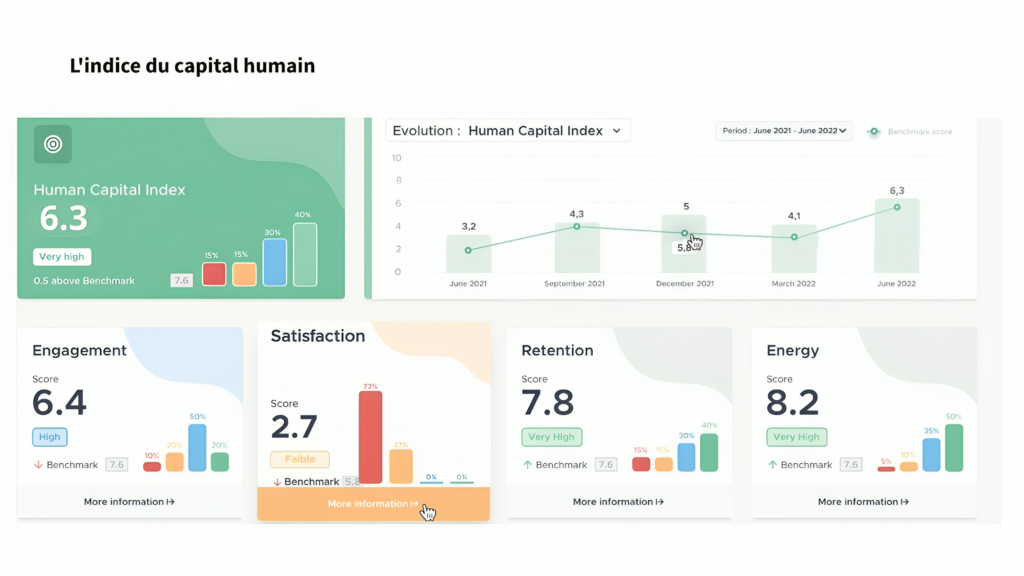Posté le
4 reading time

HR dashboards enable making informed and essential decisions to foster organizational success. These are valuable tools allowing HR professionals to collect, analyze, and visualize key data about employees and the HR process.
In this article, we will explore what an HR dashboard is, its advantages, how to build it, and the key performance indicators (KPIs) to follow. We will present a simplified example of an HR dashboard, as well as the software available for its implementation. We will conclude by presenting the Balencio HR dashboard.
What is an HR dashboard?
An HR dashboard is a management tool that provides an overview of human resources data within an organization. It allows HR managers to track and analyze various aspects such as recruitment, staff retention, training, performance, employee satisfaction, etc. These dashboards offer a synthetic and visual overview of key information, making strategic decision-making easier.
The benefits of an HR dashboard
HR dashboards offer numerous benefits, including:
- Informed decision-making: they provide relevant and real-time data. They enable HR decision-makers to make fact-based decisions rather than relying on intuition.
- Trend identification: they allow for identifying trends and emerging issues in human resources management. This facilitates the implementation of continuous improvement strategies.
- Process optimization: they help identify inefficient processes or bottlenecks. This allows for optimizing them for better productivity and employee satisfaction.
- Alignment with strategic objectives: they help align HR initiatives with the organization’s strategic objectives by providing relevant data to assess HR’s contribution to achieving these objectives.
How to build your HR dashboard?
Building an effective HR dashboard involves several steps, including:
- Defining goals and key performance indicators (KPIs): identify specific HR goals you want to achieve. Next, determine the indicators that will help you measure your progress towards these goals.
- Collect data: identify relevant data sources such as HR management systems, employee surveys, etc. Establish processes to collect this data regularly and reliably.
- Choose appropriate visualizations: select data visualizations that will clearly present information and highlight the most important trends and insights.
- Implement the dashboard: use data visualization tools such as specialized software or spreadsheets to create and implement your HR dashboard.
Key performance indicators (KPIs) to follow
The key performance indicators (KPIs) to follow in an HR dashboard may vary depending on the specific objectives of the organization. Some commonly used indicators include:
- Employee turnover rate: the percentage of workers leaving an organization over a given period. A high turnover rate can indicate issues with staff retention, company culture problems, or challenges related to employee satisfaction;
- The absenteeism rate : the percentage of lost working time due to employee absence compared to scheduled working time. A high absenteeism rate can indicate issues with health, motivation, or personnel management;
- The rate of trained employees and the return on investment (ROI) of training: the percentage of employees who have completed a training program compared to the total number of employees, as well as the effectiveness of these training programs in terms of return on investment.
- Employee satisfaction index Employee satisfaction index: This is a subjective measure of overall employee satisfaction with their work and work environment. A high satisfaction index is often associated with increased productivity, better employee retention, and reduced turnover.;
- Performance evaluations: these involve evaluating individual employee performance against the organization’s goals and expectations. The results of performance evaluations can be used to identify employees’ strengths and areas for improvement, as well as to guide all decisions regarding compensation, promotion, and professional development.
Available software
Several software options are available for creating and managing HR dashboards, including Microsoft Excel. The latter is widely used for creating HR dashboards due to its availability and familiarity. However, it may not be the most practical solution for complex human resources management needs. Excel has limitations in terms of real-time data management, collaboration, and advanced visualization capabilities.
Examples of HR dashboards
As noted, Microsoft Excel may have limitations in addressing the complex needs of human resources management. To illustrate these limitations, here’s a concrete example of an HR dashboard created in Microsoft Excel. You can see that Excel offers basic functionality for dashboard creation. It remains limited for advanced human resources management requirements:
- Limitation of visualization features: the visualization options are quite basic and not very interactive.
- Limited real-time data management: Excel is not the best solution for managing real-time HR data. This can lead to delays or inconsistencies in reports.

Excel is an initial option for creating HR dashboard content. However, it is important to recognize its limitations and explore more specialized solutions to meet advanced human resources management needs.
Introduction to the Balencio HR dashboard
In addition to the traditional HR dashboard tools, we are pleased to introduce you to the Balencio Human Capital Index.
This index, designed to seamlessly integrate with your HR management system, offers a dynamic approach to measuring:
- Engagement
- Retention
- Satisfaction
- The energy of your collaborators.

Through a concise and effective module consisting of four key questions, the Human Capital Index provides a synthetic overview of your company’s organizational health. This overall perspective is enriched by individual tracking of each indicator, for precise analysis and targeted intervention to improve performance and well-being within your organization.
In addition to measurement, the Human Capital Index stands out for its benchmarking function. This feature allows you to position your company relative to other players in your sector or region. You thus have a frame of reference to assess your performance and identify strategic improvement levers.
By integrating Balencio’s Human Capital Index into your HR dashboard, you enrich your understanding of the “employee experience”. You also promote a culture of continuous improvement aligned with your strategic HR objectives. Book your demo with our team.
Balencio’s HR news directly in your inbox
{Newsletter form}